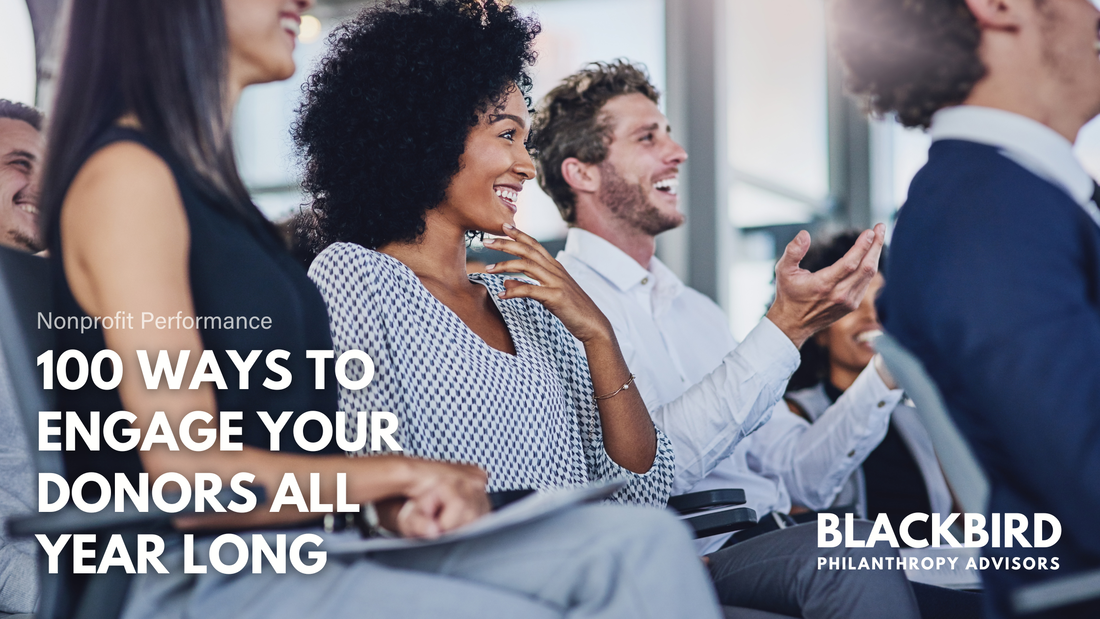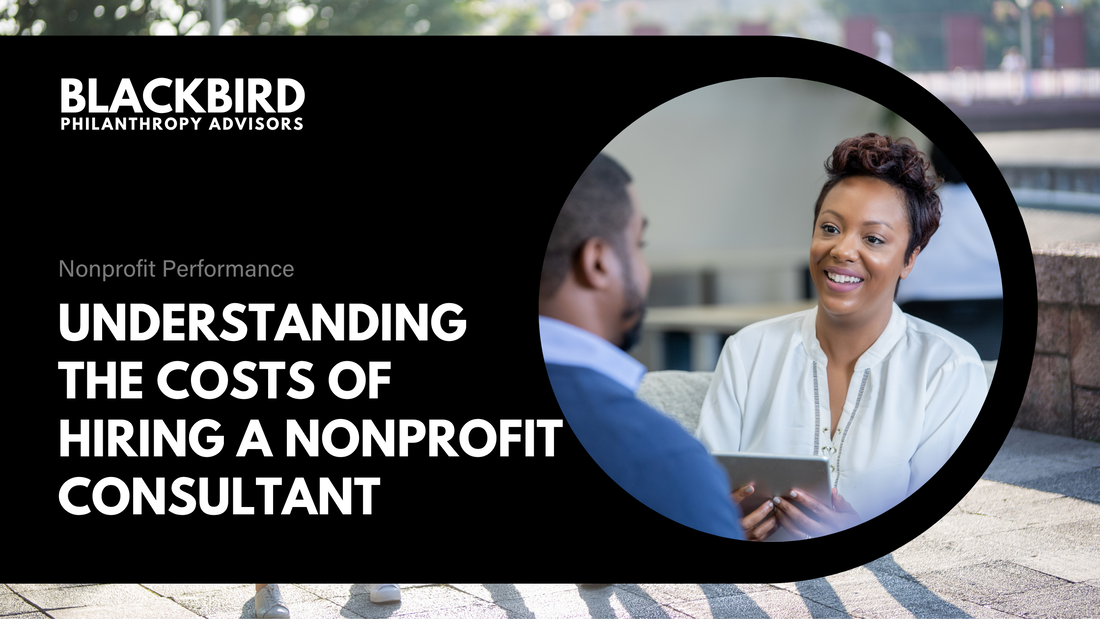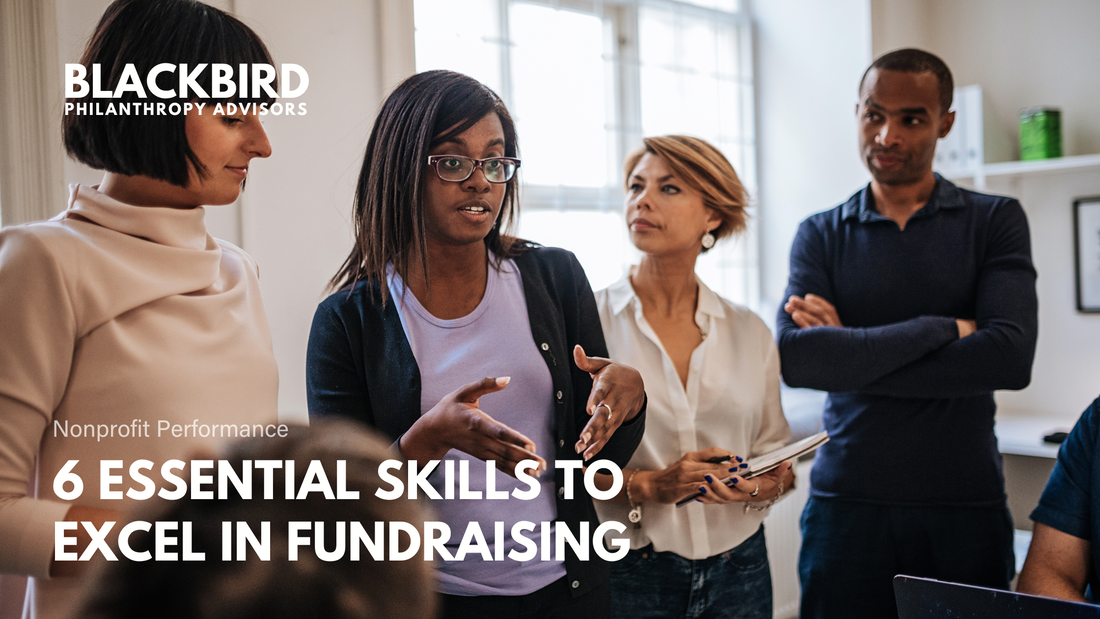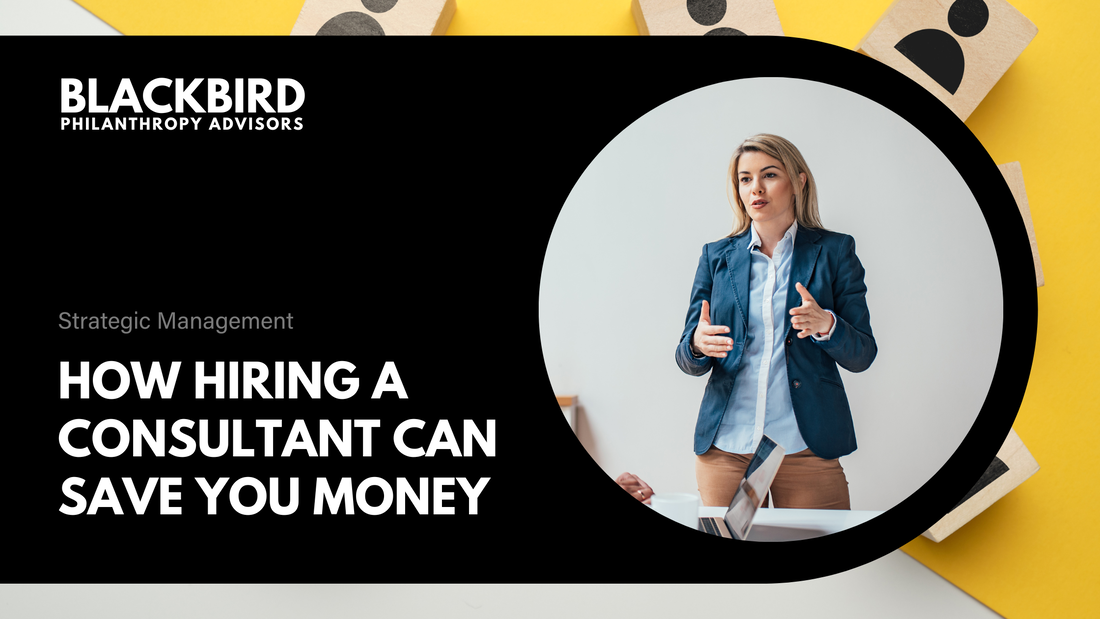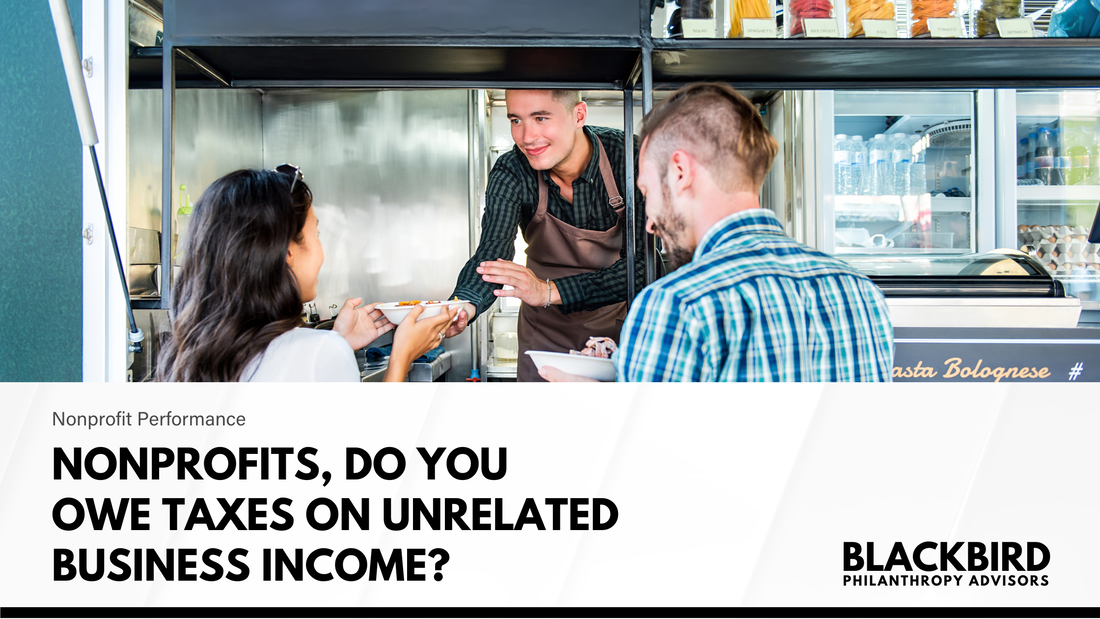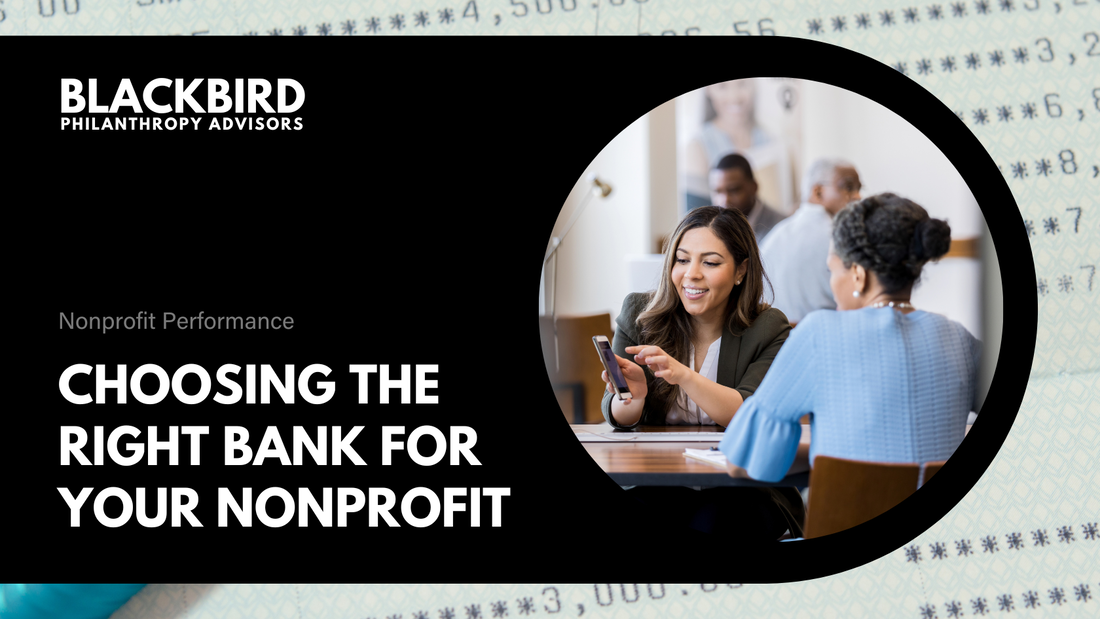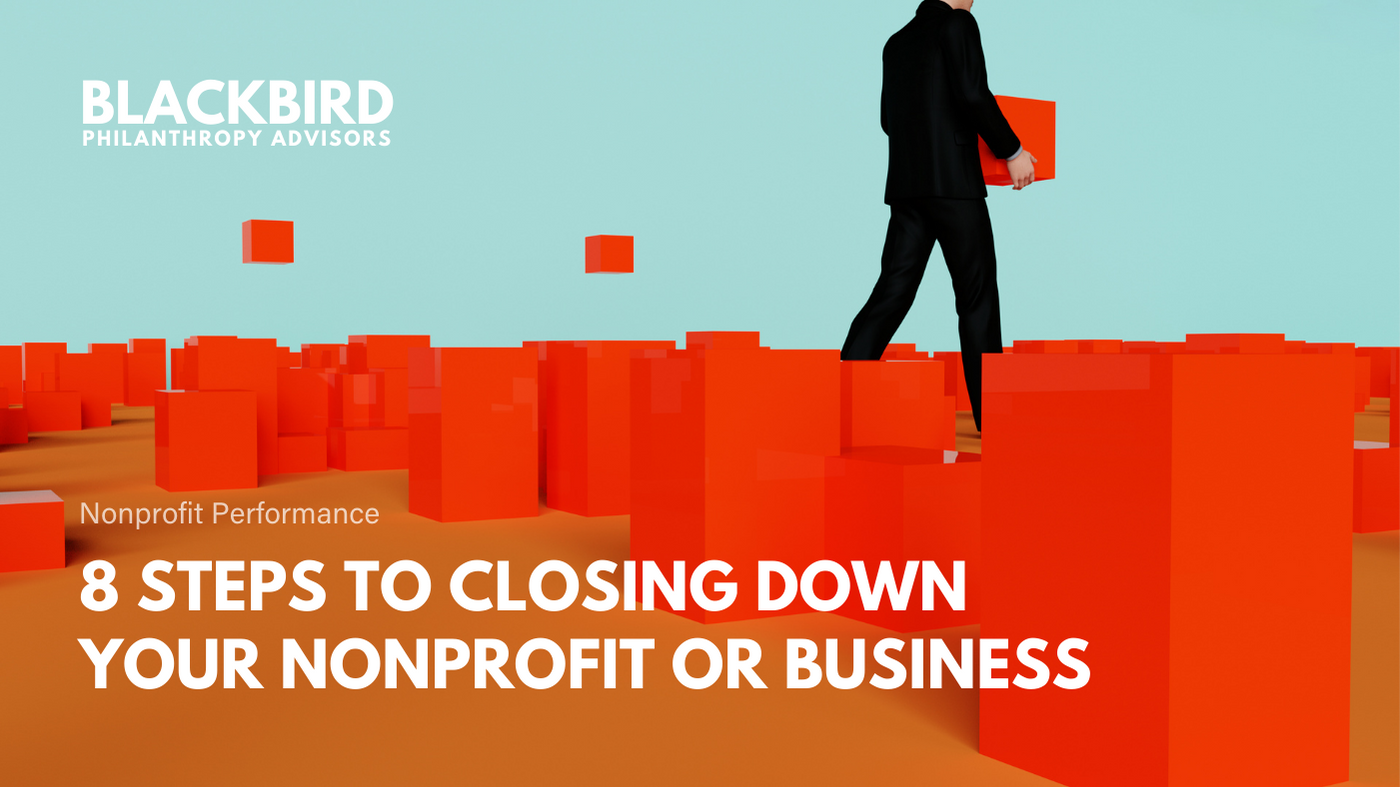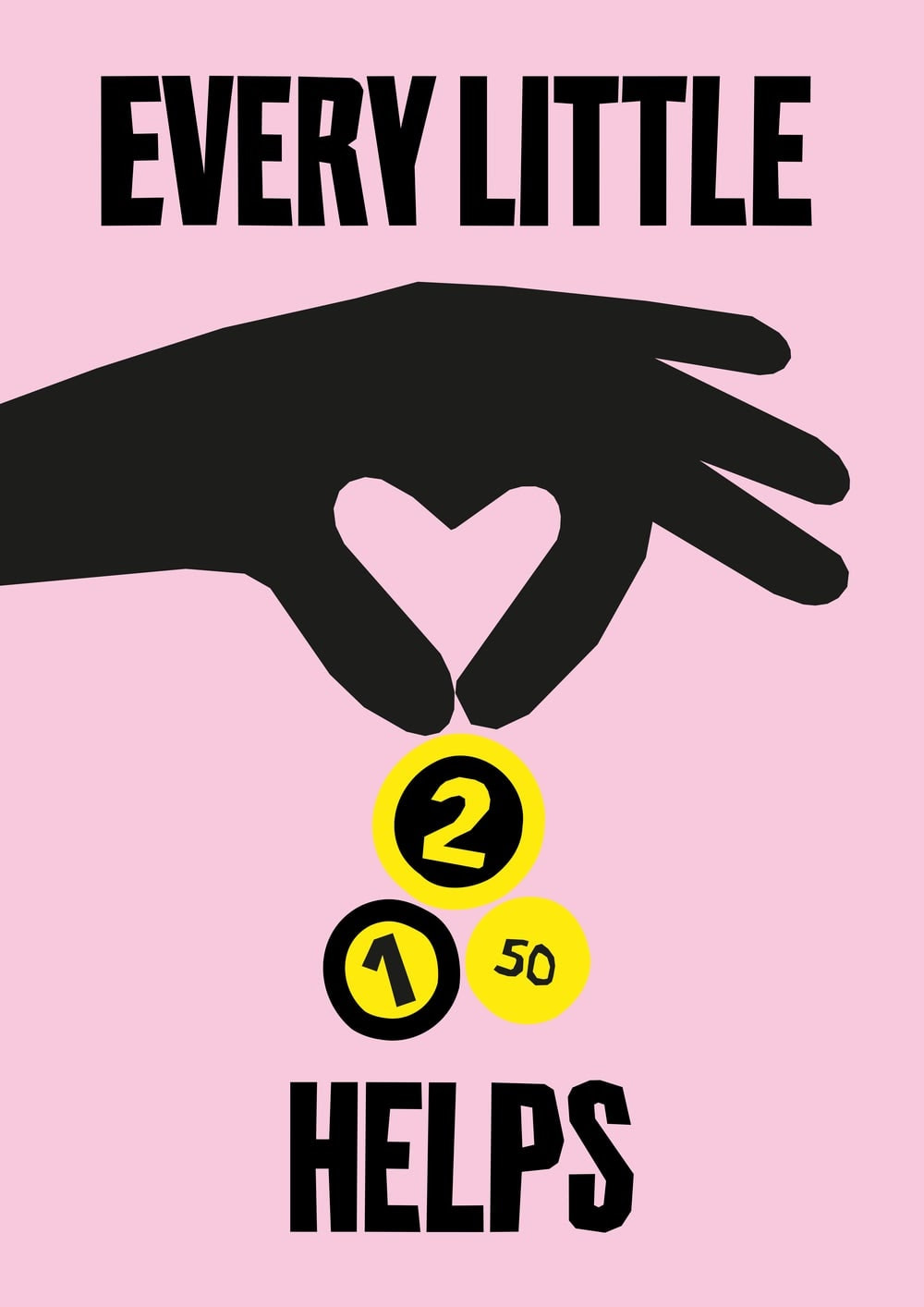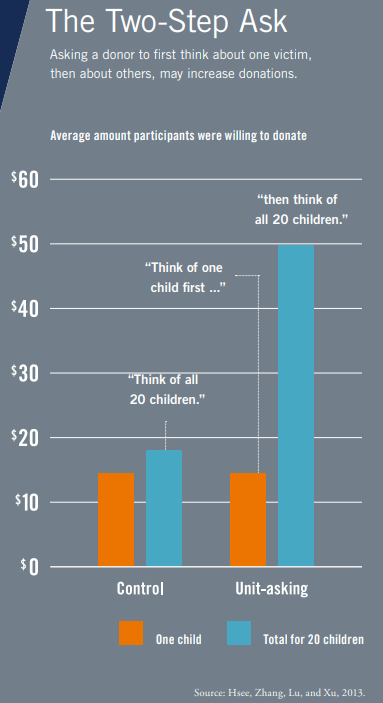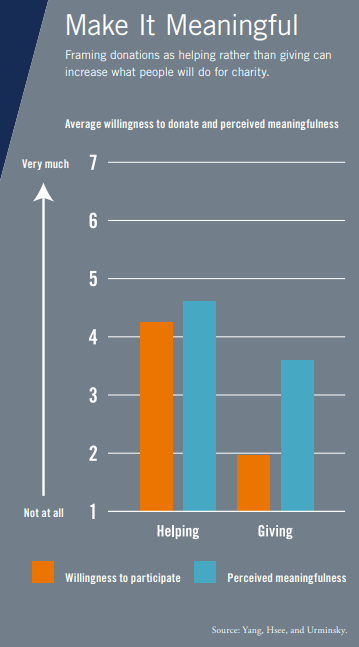Social Impact InsightsOur blog provides insights for social impact professionals in business and nonprofits. We offer advice on making the greatest impact in your organization by giving clear real-world advice on important topics of today.
|
100 Ways to Engage Your Donors and Volunteers in your Nonprofit Mission Throughout the Year12/6/2023 Engaging donors is vital for building trust and securing future funding for nonprofits. This engagement creates a meaningful relationship beyond mere transactions, making donors feel valued and connected to the cause. By acknowledging their contributions and involving them in the mission, nonprofits foster a sense of community and partnership. This personalized approach deepens trust, showing donors that their support truly makes a difference. As trust grows, so does the likelihood of continued and increased donations. Engaged donors are more likely to become long-term supporters and advocates, spreading awareness and attracting more funding, thus fueling the nonprofit's ability to make a greater impact.
0 Comments
Many people wonder if they could afford to hire a nonprofit performance consultant. Our answer is simple in many cases: you can't afford not to. Do you want to be the best leader possible? Do you need an extra pair of hands? Do you need temporary support? Do you want to spend all of your energy working toward you mission? Would you like to improve in areas where you feel you face more challenges? These are all good reasons to hire a consultant. Running a nonprofit organization requires expertise across various domains, and sometimes seeking assistance from a nonprofit consultant becomes essential. However, understanding the costs involved in hiring a nonprofit consultant can be challenging. In this blog post, we will explore the typical costs associated with different services offered by nonprofit consultants, whether it's fundraising coaching, event management, strategic planning, or other essential areas. Fundraising Coaching: Fundraising coaching typically involves guiding nonprofits in developing effective fundraising strategies, donor cultivation, and campaign planning. Costs for fundraising coaching can vary depending on the experience and reputation of the consultant. On average, expect to pay a flat fee of $1,500 to $5,000 per month or an hourly rate ranging from $100 to $350. Special Events Management: For managing special events such as galas, auctions, or benefit concerts, nonprofit consultants can assist with planning, logistics, and execution. Flat fees for special events management can range from $3,000 to $10,000, while an hourly rate may fall between $75 and $250. Marketing Communications: Nonprofit consultants can help develop marketing strategies, branding initiatives, and communication plans to increase visibility and engagement. Typical costs for marketing communications range from $2,000 to $8,000 per month as a flat fee, or an hourly rate of $75 to $300. Website Development: When hiring a nonprofit consultant for website development, costs can vary depending on the complexity of the website, desired features, and customization requirements. Typically, consultants charge a flat fee ranging from $3,000 to $25,000 or more, depending on the scope of the project and ongoing maintenance needs. Fundraising Appeal Writing: Crafting compelling fundraising appeals requires expertise in storytelling and persuasive writing. The costs for fundraising appeal writing can be estimated at $500 to $2,500 per appeal, depending on the complexity and length. Performance based bonuses including percentage-based commissions, tiered incentives, or discretionary bonuses based on overall fundraising success may be part of the contract. Capital Campaign Management: Capital campaigns involve significant fundraising efforts for large-scale projects. Nonprofit consultants overseeing capital campaigns usually charge a percentage of the funds raised, typically ranging from 5% to 10%. Performance based bonuses including percentage-based commissions, tiered incentives, or discretionary bonuses based on overall fundraising success may be part of the contract. Grantwriting: Grantwriting involves researching, preparing, and submitting grant proposals to secure funding from foundations and grant-making organizations. Consultants may charge a flat fee per grant proposal, ranging from $1,000 to $5,000, or an hourly rate between $75 and $150. Performance based bonuses including percentage-based commissions, tiered incentives, or discretionary bonuses based on overall fundraising success may be part of the contract. 501c3 Formation: For organizations seeking assistance in forming a 501c3 nonprofit status, consultants can help with legal and administrative processes. Flat fees for 501c3 formation services can range from $2,000 to $10,000, depending on the complexity of the organization. General Nonprofit Administration Consulting: Consultants providing general nonprofit administration guidance offer expertise in governance, policies, procedures, and organizational structure. Costs for general nonprofit administration consulting may range from $100 to $400 per hour, or a flat fee based on the scope and duration of the project. Strategic Planning: Strategic planning consultants assist in developing long-term goals, objectives, and strategies for nonprofits. Costs for strategic planning services can vary widely, depending on the organization's size and complexity. Expect flat fees in the range of $5,000 to $20,000 or hourly rates between $150 and $500. Human Resources Management: Nonprofit consultants specializing in human resources can provide guidance on recruitment, performance management, policies, and compliance. Costs for HR management consulting may range from $100 to $300 per hour, or a flat fee based on the scope of work. Outsourced Bookkeeping: Outsourcing bookkeeping services to a nonprofit consultant can streamline financial management and ensure accurate record-keeping. Costs for outsourced bookkeeping services vary based on the size and complexity of the organization's finances. Typically, consultants charge an hourly rate ranging from $50 to $300 or offer a monthly flat fee starting from $500 to $2,500, depending on the volume of transactions and reporting requirements. It's important to note that these cost ranges are approximate and can vary based on factors such as the consultant's experience, geographic location, and the specific needs of your nonprofit organization. When considering hiring a nonprofit consultant, it's crucial to discuss pricing structures, deliverables, and expected outcomes to ensure a clear understanding of the services provided and associated costs. A cheaper hourly rate consultant may not always be the best decision. Take for example an inexperienced grantwriter who charges $50 per hour may end up billing you for 40 hours ($2,000) for something an experienced writer, charging $200 per hour, may be able to accomplish in 10 hours of work ($2,000) with a higher quality output and fewer errors. Remember, investing in the expertise of a nonprofit consultant can yield significant benefits by improving efficiency, increasing revenue, and enhancing overall organizational effectiveness. Carefully evaluating the costs and aligning them with your nonprofit's budget and goals will help you make an informed decision and maximize the impact of the services provided by a nonprofit consultant. Fundraising is a vital aspect of nonprofit organizations, providing the necessary financial resources to support their mission and programs. Nonprofit leaders play a crucial role in driving successful fundraising efforts. To effectively navigate the complex and competitive landscape of fundraising, nonprofit leaders must possess a diverse set of skills. In this blog post, we will explore the key skills that nonprofit leaders need to succeed in fundraising and make a lasting impact on their organizations. 1. Relationship Building: One of the fundamental skills that nonprofit leaders need for successful fundraising is the ability to build and nurture relationships. Building strong relationships with donors, supporters, and stakeholders is crucial for cultivating trust, loyalty, and long-term engagement. Effective leaders invest time in getting to know their donors personally, understanding their motivations, and tailoring their fundraising strategies accordingly. They prioritize building genuine connections based on shared values and a common vision. 2. Communication and Storytelling: Effective communication is at the heart of successful fundraising. Nonprofit leaders must possess exceptional communication skills to convey their organization's mission, impact, and financial needs to potential donors and supporters. They should be able to craft compelling stories that evoke emotions and inspire action. By effectively communicating the importance of their cause and the impact of donor contributions, nonprofit leaders can create a sense of urgency and motivate individuals to support their organization financially. 3. Strategic Thinking: Fundraising requires strategic thinking and planning. Nonprofit leaders must be able to analyze the funding landscape, identify potential funding sources, and develop comprehensive fundraising strategies aligned with their organization's goals. They should be capable of identifying opportunities, anticipating challenges, and adapting their strategies to changing circumstances. Strategic thinking involves setting realistic fundraising targets, developing action plans, and evaluating the effectiveness of different fundraising initiatives. 4. Financial Management: A solid understanding of financial management is essential for nonprofit leaders involved in fundraising. They need to be knowledgeable about budgeting, forecasting, and financial reporting to ensure transparency and accountability to donors. Nonprofit leaders should have the ability to create and manage budgets, track financial performance, and demonstrate responsible stewardship of funds. By showcasing sound financial management practices, nonprofit leaders can instill confidence in potential donors and strengthen their fundraising efforts. 5. Networking and Collaboration: Nonprofit leaders need strong networking and collaboration skills to expand their reach and access a wider donor base. Building relationships with individuals, businesses, foundations, and other nonprofit organizations can lead to strategic partnerships, shared resources, and collaborative fundraising opportunities. Effective leaders actively engage in networking events, conferences, and community gatherings to establish connections and foster mutually beneficial relationships. By leveraging these networks and collaborations, nonprofit leaders can enhance their fundraising efforts and create a larger impact. 6. Data Analysis and Evaluation: Nonprofit leaders must have the ability to analyze data and evaluate the success of their fundraising strategies. They should be comfortable working with fundraising software and tools to track donor contributions, measure campaign effectiveness, and identify trends and patterns. By leveraging data-driven insights, nonprofit leaders can make informed decisions, refine their fundraising approaches, and optimize their efforts for better results. Fundraising is a critical aspect of nonprofit leadership, and mastering the necessary skills is key to achieving success. Nonprofit leaders who possess strong relationship building, communication, strategic thinking, financial management, networking, and data analysis skills are better equipped to navigate the challenges of fundraising. By continuously honing these skills, nonprofit leaders can inspire donors, mobilize resources, and make a significant impact on their organizations and the communities they serve. Hiring a contractor or consultant to perform work for your company or organization could result in significant cost savings while also providing a high level of expertise you may not be able to afford otherwise. The cost savings associated with hiring a consultant versus a permanent staff member can vary depending on several factors such as the level of expertise required, the length of the project, and the specific scope of work. Here are some potential cost savings that organizations may experience by hiring a consultant rather than a permanent staff member: Lower Overhead Costs:
Reduced Hiring Costs:
Hiring a consultant instead of a permanent staff member can provide significant cost savings for organizations, particularly for short-term or specialized projects. However, it is important to carefully evaluate the costs and benefits of each option before making a decision.
As a nonprofit organization, you may be familiar with the concept of tax-exempt status. However, it's important to understand that there are some types of income that are not exempt from taxes, known as unrelated business income (UBI) tax.
What is Unrelated Business Income Tax? Unrelated business income tax is a tax on income that is earned by a nonprofit organization through a trade or business that is not related to the organization's primary exempt purpose. The purpose of this tax is to prevent nonprofit organizations from using their tax-exempt status to gain an unfair advantage over for-profit businesses. Examples of Unrelated Business Income Here are fifteen types of income that may qualify as unrelated business income:
Reporting Unrelated Business Income Tax Nonprofit organizations that earn unrelated business income are required to report it on Form 990-T, also known as the Exempt Organization Business Income Tax Return. The organization must file this form if it has gross income of $1,000 or more from unrelated business activities. In addition to reporting the income, the organization must also calculate and pay any taxes owed on this income. The tax rate for unrelated business income varies depending on the amount of income earned, but it generally ranges from 21% to 28%. It's important for nonprofit organizations to understand their obligations when it comes to unrelated business income tax. Failing to report or pay taxes on unrelated business income can result in penalties and potential loss of tax-exempt status. Consequences of Not Reporting UBI If a nonprofit fails to file Form 990-T to report their unrelated business income tax (UBIT), they may face penalties and potential loss of tax-exempt status. The penalty for failing to file Form 990-T is $20 per day, up to a maximum of $10,000 or 5% of the organization's gross receipts, whichever is less. Additionally, if the IRS determines that the failure to file was willful, the penalty increases to $1,000 per day, up to a maximum of $50,000. In addition to penalties, failing to report UBIT can also jeopardize a nonprofit's tax-exempt status. If the IRS determines that a nonprofit is engaged in a substantial amount of unrelated business activity and has not reported it, the organization may lose its tax-exempt status. Unrelated business income tax can be a complex topic for nonprofit organizations to navigate, but it's an important aspect of maintaining tax-exempt status and ensuring compliance with tax regulations. By understanding what types of income qualify as unrelated business income and how to report it, nonprofit organizations can protect their tax-exempt status and continue to serve their communities in a financially responsible manner. Choosing the right bank for a nonprofit organization is a crucial decision that can have a significant impact on the organization's financial stability and ability to achieve its mission. Nonprofit organizations may face several unique challenges when it comes to banking, such as difficulty accessing loans or lines of credit, limited options for fee-free banking, and the need to manage donor funds and maintain transparency and accountability. Additionally, nonprofit organizations often have fluctuating cash flows, which can make it challenging to maintain consistent account balances and avoid overdraft fees. With so many banks and financial institutions to choose from, it can be challenging to know where to start. In this blog post, we'll explore the key factors that nonprofits should consider when selecting a bank. 1. Mission Alignment The first and most critical factor to consider when selecting a bank for a nonprofit organization is mission alignment. The bank should share the nonprofit's values and mission, and be committed to supporting the organization's work. Nonprofits should look for banks that have a history of working with nonprofit organizations and have a track record of supporting causes that align with their mission. Because of the unique challenges related to banking for nonprofits, you will want to have a bank that has experience working with nonprofit entities. 2. Fees and Costs Nonprofits should be mindful of the fees and costs associated with banking services. Banks typically charge fees for various services, such as account maintenance, wire transfers, and ATM usage. These fees can add up quickly and eat into the organization's budget. Nonprofits should look for a bank that offers low or no-cost banking services or provides discounts for nonprofit organizations. 3. Accessibility and Convenience Accessibility and convenience are also critical factors to consider when selecting a bank for a nonprofit organization. Nonprofits should look for a bank that has a convenient location and offers online banking services, mobile banking, and payment processing. This will make it easier for the organization to manage its finances and access its funds when needed. If your nonprofit operates outside of your headquarters state, make sure executives can access the banking services from anywhere. 4. Customer Service Customer service is another essential factor to consider when selecting a bank for a nonprofit organization. Nonprofits should look for a bank that provides excellent customer service and is responsive to their needs. The bank should have a dedicated team that specializes in working with nonprofit organizations and understands the unique challenges they face. Consider the availability of customer service representatives and the responsiveness of the bank's support team. 5. Security and Fraud Protection Security and fraud protection are critical considerations for any organization, but they are especially important for nonprofits. Nonprofits should look for a bank that offers robust security features, such as two-factor authentication and fraud prevention tools. The bank should also have a system in place for quickly detecting and addressing any fraudulent activity. Ensure that the bank has robust security measures in place to protect your funds and investments from fraud or cyberattacks. Ask about their policies for data protection, encryption, and fraud prevention. Of course, you will also need to verify that the bank is FDIC insured, which means that your funds are protected up to $250,000 in case the bank fails. 6. Interest Rates and Investment Opportunities Nonprofits should consider the interest rates and investment opportunities offered by the bank. Nonprofits should look for a bank that offers competitive interest rates on its deposit accounts and provides investment opportunities that align with the organization's financial goals. 7. Reputation It's important to choose a bank with a good reputation and a history of stability and reliability. Look for a bank with positive reviews and feedback from other nonprofits or businesses, and consider their track record of financial performance. Conduct due diligence and research potential banks thoroughly before making a decision. This can include reading reviews and ratings, comparing fees and services, and asking for recommendations from other nonprofits or trusted advisors. Selecting the right bank for a nonprofit organization requires careful consideration of several factors. Nonprofits should look for a bank that shares their values and mission, offers low or no-cost banking services, is accessible and convenient, provides excellent customer service, has robust security and fraud protection measures in place, and offers competitive interest rates and investment opportunities. By taking these factors into account, nonprofits can find a banking partner that will help them achieve their financial goals and further their mission. Closing down a nonprofit or small business can be a difficult and emotional process. However, it is sometimes necessary due to financial constraints, lack of resources, changes in the market, or other reasons. If you find yourself in this situation, it's important to know the steps you need to take to properly close down your organization. In this blog post, we'll outline the key steps you need to take to close down a nonprofit or small business.
Closing down a nonprofit or small business can be a challenging process, but by following these steps you can ensure that you do so in a responsible and professional manner. If you need help with any of these steps, be sure to consult with legal or financial professionals who can provide guidance and support. The philanthropy landscape has changed just within the past year. With different causes emerging to the forefront of the news cycle, the priority of philanthropists has also shifted to focus on contributing to issues that have been highlighted since last Spring. The Black Lives Matter movement has been around since 2013, but only recently has there been a surge in donations towards this cause and many other Black-owned nonprofits. Philanthropists have switched gears and invested more of their time and money into nonprofits that support social change, Black communities, and Black leaders.
Businesses Contributing to Social Justice While the Black community and community of color have faced countless acts of injustice, it took the events of the pandemic and highly publicized murders occurring last year to shine light on many of the issues these communities have been dealing with. Since then, corporations have been taking a role in funding these movements and supporting people in these communities. The George Soros Foundation pledged to distribute $220 million to organizations and leaders in Black communities. These contributions were spread across a variety of organizations from those that foster civic engagement in Black communities to those working in public safety, incarceration, and the police. This foundation, like others, is dedicated to showing a long-term commitment to supporting organizations that work with social justice-related issues. Well-known corporations have also stepped in when it comes to donations. Chick-fil-A gifted $5 million in grants to serving black communities and nonprofits. Other business giants have reached out to Black and minority owned businesses to provide support. Netflix pledged to support Black-owned businesses in Los Angeles and PepsiCo planned to invest over $400 million in Black communities and in developing Black leaders, especially at their own company. They committed to making these contributions over the next five years. Organizations to Invest InThere are plenty of organizations focused in the racial justice sector to contribute to. Many websites like Charity Navigator can help you search for and evaluate nonprofits. They include highly rated charities that promote Black health, education, rights, and community development. Other nonprofits to donate to include: Taking popularity contests into consideration is not something that first comes to mind when engaging in charitable work. While we would hope that all organizations doing nonprofit work on behalf of a variety of causes are receiving the aid they need, this is simply not the case. There are differences when it comes to the type of causes that people like to fund. This doesn’t mean that it is impossible for less “popular” causes to raise money, but that more innovation and dedication may be required to raise funding for their goals. Those willing to rise to the challenges of these obstacles can still do great work for their causes.
Funding Priorities Around the World Donors around the world have different viewpoints on organizations they are willing to fund. A study from WealthInsight has shown that, overall, philanthropists are most involved when it comes to funding cultural institutions, academic institutions, and healthcare. In 2017 alone, health related charities saw a 15.5 percent rise in donations from American households. Causes that seemed to be less popular among donors in the world include religion, sports, human rights, and military causes. However, preferences vary by region with those in the Americas and Europe seeing more donations to health and culture causes while education dominates donations in Asia, Africa, and the Middle East. There are also more variations when you investigate each sector. While health may be a top priority for many philanthropists, areas in health that touch on issues like mental health, addiction, or sexual health see significantly less donations than health organizations that address topics like cancer. For example, the nine cancer charities in the top 100 fundraising charities have a combined income larger than the 13 charities in the top 100 related to other health issues. Facing the Road Ahead There’s plenty of actions organizations can take if they are looking to boost their donations. The key is showing others the importance of advocating and supporting the cause the organization is passionate about. Take an active role in educating about the cause and show evidence of the impact a donor’s funding can make. Continue to appeal to the public’s emotions and take advantage of opportunities to elevate the nonprofit’s profile. A good reference is an article published in the International Journal of Nonprofit and Voluntary Sector Marketing touching on “unpopular causes and how they can achieve fundraising success”. There may be a tough road ahead but, holding on to a positive outlook and having specific strategies on the fundraising journey can play an important role in how successful an organization is. One of the considerations that comes up when you decide to participate in charitable giving is the topic of anonymity. Depending on the type of person you are and the effects you are looking for, giving anonymously may seem like the way to go rather than making your donations well-known to everyone. There’s arguments for each side and ultimately, the decision is up to you. Before making your next philanthropic move, weigh the advantages and disadvantages of giving anonymously and publicly.
Giving Anonymously There are plenty of factors that go into making the decision to be anonymous in your giving. These can include your background, the organization you are supporting, etc. Here are the advantages and disadvantages associated with giving anonymously: Disadvantages
Advantages
Giving Publicly Disadvantages
Public donations are preferred by many organizations and offer them more opportunities and benefits than you may realize. For example, the more donors they are able to publicly include on their list, the more likely they are able to grow their work with the community. Not only does your donation help fund their projects, you name attached to a charitable gift can be used to help elevate fundraising efforts, create compelling stories, and help the organization build a relationship with you as a donor. The COVID-19 virus has rapidly changed the way we live our daily lives. Businesses and nonprofits have been struggling with the economic impact and additional hardships brought about by the pandemic. There are a variety of relief funds available for businesses that need extra help during this unprecedented time. Recently passed legislation included $900 billion in aid to those affected and many foundations have set aside COVID-19 specific funding available to small businesses, nonprofits, and individuals.
CARES Act and Pandemic Relief Bill The new stimulus package passed just before the holidays included relief and aid to individuals and businesses who were awaiting news of the next stimulus package. This relief bill contained renewals of a variety of funding offered through the first stimulus package and includes a variety of aid for specific populations and small businesses/nonprofit organizations also. COVID-19 Economic Injury Disaster Loans The CARES Act includes $20 billion for EIDL grants (economic injury disaster loan program). These grants are meant to provide economic relief for small businesses and nonprofit organizations that are experiencing a temporary loss of revenue and include aid for businesses in low-income communities. EIDL funds can be used to help cover normal operating expenses including health care benefits, rent, utilities, etc. Entertainment and Theatre Venues $15 billion of CARES Act funding has been set aside to help entertainment and theatre venues. This is known as the “Save Our Stages” Act and includes live venues, independent movie theatres, and cultural institutions. Organizations will need to have experienced a 25 percent revenue decline compared to same quarters from previous years. These allocations can include up to $10 million in aid for each organization. The Small Business Administration (SBA) is currently working on applications which will be posted on grants.gov and will host a pre-application informational webinar beforehand. Paycheck Protection Program (PPP2) An additional $285 billion in loans was approved under the Paycheck Protection Program. This funding is available to those with fewer than 300 employees that experienced at least a 25 percent decrease in revenue from quarters from previous years. $12 billion of this funding was specifically earmarked for minority-owned businesses, ensuring that many diverse and low-income communities will receive the aid they need to sustain their businesses. Applications for Paycheck Protection Program loans are currently being accepted by the Small Business Administration (SBA) from participating community financial institutions (CFIs) and lenders. Click here for access to the full text of the bill. Grant Funders and Foundations For those looking for funding outside of federal opportunities, there are many grant funders and foundations who are providing aid to small businesses, nonprofits, and individuals. Small businesses, nonprofit organizations, and individuals who are looking for a resource list of available grants and funding opportunities can utilize the following websites for their searches:
Small Businesses
Nonprofit Organizations
Individuals
The COVID-19 pandemic and the need for social distancing have changed pretty much everything about how we live and work, and for nonprofit organizers, even the way you fundraise has changed. Fundraising and fostering donors used to be a social job, one that required lots of face-to-face interaction with donors at special events. No longer able to engage donors in person, fundraisers everywhere are discovering new ways to keep donations coming and keep their donors invested in their cause. Here, we’re sharing 10 of the easiest, most creative, and most effective ways to engage your nonprofit donors virtually. 10. Share a Message From The Top Nonprofit leaders and executives have difficult, time-consuming jobs, requiring them to be excellent delegators as well as leaders. Because of this, not all nonprofit leaders manage to personally thank or reach out to donors, or only make appearances on occasion for important moments. Now, with uncertainty and confusing consuming everyone’s lives, sharing a message from the top of your organization can help to put your donor’s minds at ease. Recruit organization executives to share their take on the current state of the world, to offer words of advice or encouragement to donors and followers in the form of a letter or email, or to make a short video thanking everyone for their continued support through difficult times. Showing that the individuals at the top of your organization are paying attention to what the world and their donors are experiencing will help maintain active volunteer and donor active engagement in your cause. 9. Organize a Webinar Was your organization planning to host special events, courses, seminars, or other events in 2020? Do you already have speakers, presenters, and panelists lined up and on the schedule? Have you already sold or handed out tickets to the event? Don’t worry about your hard work being for nothing just yet; pivot your event and create a webinar where you can virtually host presentations, panel discussions, interviews, and much more. 8. Send a Weekly E-Newsletter With so much uncertainty in the world, it’s nice to have something you can depend on, which is why you should start sending a weekly e-newsletter to your donors. Keeping donors in the loop will not only help to remind current donors that your organization still exists and is doing good work, but can also help you to retain donors that may be unable to donate during the pandemic, encouraging them to come back and donate once they are able. 7. Create an Online Fundraising Campaign If you have never tried fundraising online, this is the perfect moment to give it a go! There are tons of ways to set up fundraising campaigns online, most of which are so easy you can do so in just minutes. Some social media platforms now include built-in fundraising tools where followers can donate with the click of a button. You can choose a dedicated fundraising site like GoFundMe. You could even organize a simple campaign using PayPal or Venmo to collect donations. 6. Start a YouTube Channel Like an e-newsletter, creating a weekly YouTube video to update donors and followers about what your organization is up to during the pandemic. If donations made by your supporters go to physical goods, create a short video showing the attaining and gathering of the items paid for with donor support. If donations go to providing community services, show your donors what facilities they contribute to or how those services are accessed by the community. Anything you might share in a newsletter can easily be shown in a video, and can help you to reach a wider range of donors. 5. Call Your Donors Personally While you can’t meet face to face with your donors to thank them for their support, you can still reach out to them one-on-one over the phone. Personally calling and thanking donors is a great way to show them that their donation makes an impact, and will help them to feel appreciated by your organization. Even if no one picks up, a quick message personally thanking them could be the thing that brightens their day and reminds them to donate again. 4. Host a Live Q&A Social media platforms like Instagram and Facebook have ‘live’ functions, which allow users to stream themselves to their followers in real-time. For nonprofit organizations, this can be a great way to boost donor engagement, and answer some commonly asked questions in front of a sizable audience. Share with your followers a few days beforehand that someone will be hosting a live Q&A from your organization, and keep reminding them up until the time you go live. Stick around for at least half an hour and encourage followers that tune in to ask questions and engage in the chat. 3. Post On Social Media Using social media to raise awareness for nonprofit organizations is nothing new, but now, with mandated social distancing in place for the foreseeable future, social media will become your main way of communicating with your donors. Regularly posting to all your social media accounts and keeping your content consistent across platforms is super important for remaining at the top of your donor’s feeds, since everyone else is at home and working hard to boost their social media presence too! Consistency is key. 2. Collaborate with Other Nonprofits Collaborating with another nonprofit involved in the same cause as your organization to post promotional or educational material on social media is a great way to expand your audience, and show that your organization has good relationships with other respected nonprofits. Cross-promote events, share each other’s posts, be active in the comments section, and do your best to highlight the best parts of each of your work. 1. Share Important News Right now, everyone could use a little good news, which is exactly why you should be sharing every positive event with your donors. When important or exciting events or milestones are reached by your nonprofit, shout it from the rooftops - or at least on your social media. Share success stories, good news from the community, exciting or positive news relating to your cause, and more. Some nonprofit organizers make the mistake of believing that their work with donors is done once they have received donations, but in truth, the work of fostering relationships with and connecting with donors is never complete. The first donation should be the first of many, and if you have put in the time and effort to cultivating close relationships with your donors, this will happen naturally.
One of the best ways to create relationships with donors and to keep them interested in your organization is by regularly keeping in contact, and the easiest way to do this is through an e-newsletter. E-newsletters can be sent via email or text, and can be displayed on your website for visitors to peruse. The newsletter format helps to keep donors informed of the goings-on of your organization, and acts as a gentle reminder that you are still out there and doing work that needs to be funded. Sending donors and supporters of your organization regular information regarding your nonprofit’s progress and work is also a good way to build trust, since your e-newsletter is the perfect place to demonstrate good stewardship. What To Include In Your Newsletter Whether you have written hundreds of newsletters, or are reading this as your first step to creating an e-newsletter for your nonprofit, the most important thing to remember is to include only information and stories your donors would be interested in. Magazines curate articles and content based on what their readers are interested in, which is why you don’t see much fashion in Bassmaster and you don’t often find mention of river safety in US Weekly. Like entertainment publications, you should be sticking to the content your donors want to see, like success stories from people, organizations, or communities that have benefited from your work. Donors like to see the impact of their donations, and including success stories in your e-newsletters is a great way to do just that. Other content that can help you to build your donor network and keep individuals engaged could include information on upcoming events, project and program updates, information on relevant news and current events, and information on how donors can volunteer, donate, and help. Despite the fact that fundraising is key to the success of most nonprofit organizations, individuals doing nonprofit work often struggle with how to approach the task of actually asking for donations. Many fundraisers feel fearful of seeming too “salesy,” or in other words, they worry about feeling like they are guilt-tripping people into donating to their cause. This fear prevents many incredible organizations from gaining sufficient donor support, all because their organizers and volunteers are too afraid of turning into “salespeople”.
Here’s the problem: technically, fundraisers are doing what salespeople do every day. Just like for-profit sales involves “selling a product” nonprofit work involves “promoting a cause”. Though nonprofit donors don’t usually walk away with a physical product, your job as a fundraiser is to convince them to buy into your cause. It’s sales! Despite not wanting to seem salesy, fundraisers and nonprofit volunteers often fall into the trap of expecting donations rather than putting in the time and effort to build relationships with potential donors. Salespeople work to relate to their leads, to find common ground, and to grab their attention by offering them something they are already looking for. You don’t see salespeople grabbing people off the street, their customers come to them. As a fundraiser, you need to be prepared to meet people where they are, rather than simply expecting them to hand over their hard-earned money to a cause just because donating to charitable causes is the right thing to do. You need to be ready to use stories and conversations to engage people in the issues, which is exactly what salespeople are doing when they talk to customers about their needs and wants in a product or service. Back in the day, work as a fundraiser was largely about shining the light on yourself and your organization. Fundraisers were able to monologue in order to gain donations and support, but that was before people had the kind of access to information we have been afforded in the age of the Internet. Now, people know what they want and are able to learn about the causes they care about independently of nonprofit organizations. It is no longer about you, but instead about listening to what it is your potential donors care about. Instead of saying “you should donate because”, or “our organization is incredible and therefore you should donate”, change the narrative to be more donor-centered. Instead of a physical product, you are selling your donors assurance that their money is going to something they care about. You should be asking them which causes they care about, then tailoring your approach to appeal directly to those donors that are most likely to empathize with your cause. Basically, you need to stop going after donors who you know nothing about and start focusing on networking to connect with people who will resonate with the work being done by your organization. The Sales Funnel for Nonprofits The “sales funnel” is simply the name given to the order of operations/tasks required to make a sale. In the business world, there are a few schools of thought regarding how many steps there are in the funnel, but here, we’ll focus on the four that are most pertinent to nonprofit fundraising. 1. Awareness The first step of the “sales funnel” is to cultivate awareness for your brand or organization. This step could also be called the “leads” or the “prospecting” phase, since it is all about finding those potential donors. Here is where we see many old-school nonprofits fall short, since their awareness/prospecting phase usually involves more broadcasting than networking. In order to find donors that will not only donate once but will become permanent supporters of your organization, it is important to dedicate the awareness phase to connecting with people who share a common interest in causes you support. 2. Interest Once you have generated leads, the next step is to follow-up and to build a relationship with prospective donors. Like salespeople talk to their leads about their specific needs in a product or service, fundraisers talk to their donors about how they can secure their donation. This phase is all about taking the interest you piqued at the first meeting and converting it into an intent to engage. 3. Decision In the nonprofit sector, this phase might more accurately be described as the “asking” phase, since this period is all about getting down to the nitty-gritty and actively asking prospects if they will be willing to commit to making a donation. In sales, this phase is where the salesperson offers the final price and waits for the customer to decide. At this point, you’ll already have built a solid relationship with your prospective donors, so asking for donations won’t feel like you are pressuring or goading anyone into doing something they don’t want to do. Like in sales, the transaction is mutually beneficial, so practice asking for donations with confidence. 4. Stewardship In business, the final step of the sales funnel is “sale”, but because nonprofit “sales” are about creating long-term donor relationships, stewardship is a far more appropriate descriptor. Once your donor has made their first contribution, your final step is to maintain a relationship and an open dialogue to encourage them to donate again in the future. If you enjoyed this guide, and want to learn more about fundraising and building relationships with donors, visit Blackbird Philanthropy Advisors and check out our blog. Every nonprofit leader and fundraising professional knows the amount of work it takes just to seek out funding opportunities, much less how difficult it can be to actually land a corporate donation, grant, or sponsorship. While individual donations and fundraising events help to manage day-to-day operations, these larger corporate donations can help to fund projects, community initiatives, organizational expansion, and so much more.
For some smaller nonprofit organizations, landing a corporate donation can feel like a long shot, especially if they have never sought out donations beyond crowdfunding or individual donations. In truth, nonprofits at every level can earn corporate donations, and you don’t have to have long-standing relationships in the world of business to get started. If you want to work with corporate sponsors to increase funding for your nonprofit, try using some of these strategies to get more donations. Build Relationships at Every Level A common misconception among smaller nonprofit groups is that you need to be connected at the highest level of a corporation in order to stand a chance of qualifying for donations. This misconception likely comes from the fact that nonprofit fundraising professionals and organization leaders do typically build relationships with corporate leaders, but this fact should not be misinterpreted to mean that opportunities lie only at the top. When your organization is seeking out corporate donations it is important to take every possible opportunity to network, which means talking to people from every level of the companies you want to work with. Small, seemingly insignificant conversations about the work your organization does could end up being your chance to get a foot in the door. Networking is absolutely essential in nonprofit work, but be sure not to become so focused on getting to the top right away. Conversation with professionals at every level can become an incredible opportunity, and you’ll be amazed at how many connections you’ll be able to make if you are open to it. Some companies even have rules against donating to any organization without the request being attached to a relationship with someone at any level within the company. Pinpoint Win-Win Opportunities Before you approach a company about donating to your organization, it is important to do the work of learning everything you can about it. Take a close look at the products or services the company offers, how they market their products, what their sales are like, whether the company is on the rise, what its community relationships look like, and so on. The more you know about the company you plan to approach, the better equipped you will be to establish a positive rapport. Once you have gathered as much information about the corporation you are interested in as possible, you will be able to pinpoint win-win opportunities that may exist for your two organizations. Imagine, for instance, that your nonprofit serves a particular community that is vested in the success of the corporation you are looking to work with, or vice versa. In this case, it would be mutually beneficial for the company to make a donation, since their donation would be going towards initiatives that indirectly benefit them. Knowing as much as possible before you reach out to request a donation can also help you to tailor a personalized sponsorship package request, which will make your case far more compelling than one of the generic requests they frequently receive. Be Open to Non-Financial Donations While we often think of ‘donations’ as being monetary, corporate donors have much more to give than just money. While financial donations can be a massive help to any nonprofit, there are plenty of corporations that specialize in services that are much needed or could be used in a way that could benefit a nonprofit-- think law, food service, accounting, insurance, entertainment. Some companies may want to offer their specific services pro bono, outfit your nonprofit with the product(s) they make, or even volunteer their own time to your cause. Remember those win-win opportunities you want to look for in order to land more corporate donations? This is a great example of exactly that kind of situation. Some companies may not even consider donating money to your nonprofit unless they are allowed to document that their employees volunteer with your organization. These kinds of non-financial donations can be extremely valuable, and should not be ignored or considered a lesser donation than a monetary one. At Blackbird Philanthropy Advisors, we work closely with businesses to help them manage and organize their philanthropic efforts. If you want to learn more, we’re sharing tons of tips, tricks, and information for nonprofit and community organizers over on our blog. Independent Sector is the only national membership organization that brings together the charitable community—a diverse set of nonprofits, foundations, and corporations—to advance the common good. The charitable sector provides millions of people with powerful, independent, and voluntary methods for addressing the issues and expressing the values most important to them.
Individuals
Small Nonprofits (Fewer than 500 Employees)
Large Nonprofits (More than 500 Employees)
Additional Resources Everything Nonprofit Leaders Need to Know about the CARES Act of 2020 During the COVID-19 Crisis3/30/2020  Written by Caitlin Worm, Managing Director of Blackbird Philanthropy Advisors Written by Caitlin Worm, Managing Director of Blackbird Philanthropy Advisors As nonprofit leaders, you’re facing unprecedented times in managing your workforce while also trying to maintain the level of quality in community services you’ve provided before the COVID19 crisis. Last Friday, the $2 trillion federal stimulus package "CARES Act" passed that could offer direct relief for your organization. I am writing to provide a summary for you of strategic options to consider as you wade through the health and economic crisis. Under the CARES Act, unemployment benefits are confirmed upon application AND benefits are upped an additional $600/week (bringing total benefit to $800-$900/wk). If you think it’s inevitable that you may eventually have to lay off workers soon, it might make more sense to lay off your staff immediately to unlock this program's benefits. Do the math, see if this makes sense for your team members and your operations. This program is here to help you get through this. The CARES Act also provides up to $10,000 advance for payroll expenditures (this is called an Emergency Economic Injury Disaster Loan, approved within three days of application). If you then plan to “rehire” May 1, you could use this loan to help get you through the month of May. Then by June, it’s likely (fingers crossed) the quarantine will be over and you can fully re-open to meet client needs. This is really more like a grant, it does not need to be repaid. This route might be able to get you through at least one month of payroll and then some payroll relief for the month of May. Something to talk to your financial advisors about, every organization is unique and requires a unique strategy. ADDITIONAL CARES ACT BENEFITS FOR NONPROFITS
If you haven’t done so already, reach out to your legal and financial counsel as soon as you can to determine what the best options are for your organization. In Indiana, we recommend Kruggel Lawton CPAs (Margene Zink mzink[@]klcpas.com) for accounting information and South Bank Legal for legal matters. Elsewhere, let me know if you’re looking and I will get you a good referral. I am not a lawyer or a CPA. I am offering ancillary support as a nonprofit administration consultant who wants to see your important organization get through this whole and on your feet. Feel free to reach out using our contact form if you have specific questions or need assistance during this tough period.  You’re excited. You’re a 501c3, you’ve got a great mission and now you’re ready to get some of those grant dollars you’ve heard so much about! Where do you begin? The good news is – it’s true, there are a lot of opportunities to find funders who want to invest in your cause. The bad news is, you may be a ways off from getting their attention. It’s especially difficult for brand new organizations to receive grant funding without 2-3 years of success under their belts to show they’re worth the investment. Hang tight and arm yourself with our list to get you and your team on the path to grant funding success. This article will give you an insider’s track guide to everything you’ll need to gather and have on-hand to begin applying for grants. 1. BALANCE YOUR BUDGET Many major funders admit, the first thing they do when they read a grant application is go straight to the budget. 9 times out of 10, a grant application will require a copy of your organization’s annual budget. On the budget, funders are looking to see that you’re fiscally solvent, fiscally responsible, and competent. How does a budget show them these things?
2. COVER YOUR BASES 99.9999% of grant funders will require that you are 501c3 tax exempt organization. Here’s a list of the all the items the vast majority of grants require.
Many grant funders will also ask for a deeper dive of information that includes:
3. KNOCK 'EM DEAD Alright, you’ve covered all your bases and now you’re ready to actually fill out the application. What kind of information will you need to fill out the application? The vast majority of grant application and letters of inquiry will ask for these four elements for the program or project you’re requesting funding for:
Many times, you’ll also be asked to include one or more (or all!) of the following:
4. GET IT RIGHT Finally, there are a number of random little red flags that may pop up around your application. Because grants are hugely competitive to win, a red flag might throw your whole application off. If you can get yourself grant-ready starting NOW, you won’t have to worry about that when you’re all set to apply.
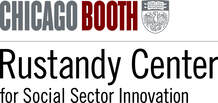 University of Chicago Booth School of Business’s Rustandy Center for Social Sector Innovation, this guide provides four research-based ideas you can implement today. The Rustandy Center for Social Sector Innovation is the Chicago Booth business school's social impact hub and destination for people tackling complex social and environmental problems. This information is provided by the Rustandy Center in their downloadable e-book here.
3. Make Your Fundraiser Exceptional
Reframing your annual fundraiser as a unique opportunity can drum up higher donations. Abigail Sussman, associate professor of marketing at Chicago Booth, finds that minor differences in the way a charity frames its donation plea, as either a regular occurrence or an exceptional one, can make a big difference in how likely people are to donate. For example, researchers altered the wording in online ads for the Alzheimer’s Association’s annual charity walk, so that one ad read “Held annually for Alzheimer’s,” while another read “Only once a year for Alzheimer’s.” People were more likely to click through and donate for the latter, when the walk appeared to be an exceptional rather than a regular occurrence. 4. Give Suggestions... Carefully Not all donors are created equal. Whether first-time donor or seasoned philanthropist, offering suggested donations can help guide their giving with positive results. “Small changes can impact people’s choices, especially for people who aren’t sure what their actual preferences are,” says Urminsky, who is conducting research with Indranil Goswami, assistant professor of marketing at the School of Management at the University at Buffalo. Urminsky and Goswami find that setting higher default donation amounts increases how much a donor gives, but can reduce the number of donors. When targeting likely donors, suggesting larger amounts can be beneficial. If boosting participation is the primary goal, setting a low default can increase donation rates. When setting default donations, understanding your donors and their commitment to giving is key.  What happens when your nonprofit is engulfed in scandal? Or what if you have a board member or highly visible donor who’s reputation is significantly on the rocks? As always, being prepared for crisis and scandal is always the best policy. Every nonprofit leader should know when and how to act in times of trouble. Managing these crises is especially important when it comes to fundraising and mission advancement. Fundraising is all about managing relationships. In times of controversy or not, nonprofit executives should be carefully navigating through their relationships with stakeholders. When there is a crisis, the trust they’ve built along the way will have the biggest impact on successfully wading through the times of murky waters. In general, it is good to have open, honest communication with all of your stakeholders so a crisis doesn’t tip you over the edge but makes everyone come out stronger. If news breaks that a major donor was engulfed in scandal, a nonprofit executive should remain calm and act swiftly with integrity. A solution and plan of action to mitigate the crisis should be immediately ready to go. This includes knowing who to pull into a room for immediate strategy, who to contact first, and who are the best people to carry out the plan. Communicating clearly, concisely is paramount. Your main strategy will need to be disassociating your mission with the person experiencing the scandal. Your core group of loyal stakeholders should continue to feel that you are an organization they can trust. Continue to align their passions and initial interest in the work of your organization with the impact and mission you make in the world. The scandal could, in effect, give you an opportunity to engage your stakeholders in a closer, meaningful way that ignites even more respect and loyalty than before. |
 RSS Feed
RSS Feed
